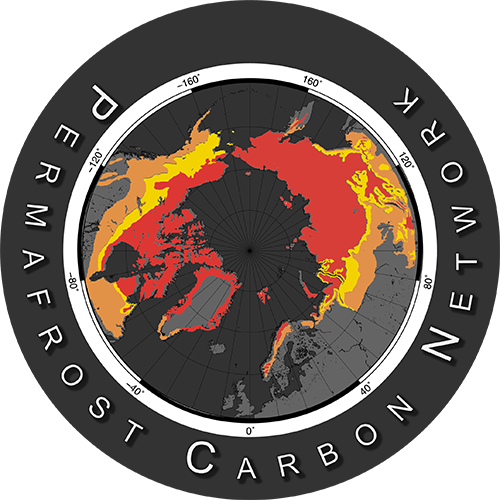1. Virtual Meeting of the Permafrost Carbon Network:
On June 13, we held a virtual meeting with synthesis leads to discuss updates on syntheses, emerging ideas and upcoming events. A lot of good progress has happened since AGU amongst other things with the following syntheses: 1) Expert assessment on subsea permafrost (also see item #6 below), 2) Thermokarst related syntheses, 3) PCN Hydrology MIP, 4) PCN 14C synthesis, 5) Vegetation Permafrost Syntheses, 6) Methane syntheses (also see item #7 below), 7) Non-growing season CO2 emissions, 8) Empirical bottom-up approach for methane fluxes, and 9) Deep Yedoma permafrost synthesis. We have posted the slide updates on our shared Google Drive. You can view the slides under this link.

2. The steering group of the Permafrost Action Team will meet next week in Fairbanks, AK.
Our agenda includes defining synthesis projects that are focused on a topic related to degrading permafrost and that are modeled after our many carbon related synthesis products.
3.
The 2nd Asian Conference on Permafrost takes place in Sapporo, Japan the week of July 2-6, 2017.
4. Call for abstracts at AGU 2017:
The Permafrost Carbon Network will again host a session at AGU, taking place in New Orleans LA. Abstract submission deadline is August 2nd
Session Details: B083: Vulnerability of Permafrost Carbon to Climate Change: Permafrost zone soils contain 1330-1580 Pg of organic carbon (C). Permafrost degradation can decrease ecosystem C storage by enhancing microbial activity and ecosystem respiration, but can also stimulate plant growth and lateral C flux, potentially increasing C stored in vegetation, soil, and sediment. This session invites papers that examine factors causing losses and gains in ecosystem C storage that relate to the question: What is the magnitude, timing, and form of C release from permafrost zone ecosystems to the atmosphere in a changing climate? Papers may address any aspect of this topic from molecular to global scales, using measurements or modeling to detect or forecast permafrost thaw and its influence on the C cycle and climate.
Conveners:
Ted Schuur, Northern Arizona University and Ben Abbott, Brigham Young University
5. 7th Annual Meeting of the Permafrost Carbon Network:
We will host our all scientist meeting the Sunday before AGU in New Orleans, LA (December 10, 2017). More details in regard to the agenda and meeting location will follow in the fall.
6. Participation in Expert assessment on subsea permafrost:
Ben Abbott, Brett Thornton, and Jennifer Frederick are leading an expert assessment on subsea permafrost. Questions will concern the current extent of subsea permafrost, carbon type and stocks, and potential changes in emissions. If you are interested in participating with the survey design and background information document or just as a participant, feel free to get in touch with Ben ().
7. Final Report: International Workshop to Reconcile Methane Budgets:
McGuire AD, Kelly BP, Sheffield Guy L, Wiggins HV, Bruhwiler L, Frederick J, Huntington HP, Jackson R, Macdonald RW, Miller CE, Olefeldt D, Schuur E, Turetsky MR (2017) Final Report: International Workshop to Reconcile Methane Budgets in the Northern Permafrost Region. eds. Available through the International Arctic Research Center (IARC) Data Archive.
8. Modeling Permafrost's Role in the Global Carbon Cycle.
Xia et al. 2017 is selected as EOS research spotlight by the editor. Click on the links for the full EOS report and the paper.
9. Some recent publications:
Celis G, Mauritz M, Bracho R, Salmon VG, Webb EE, Hutchings J, Natali SM, Schädel C, Crummer KG, Schuur EAG (2017) Tundra is a consistent source of CO2 at a site with progressive permafrost thaw during six years of chamber and eddy covariance measurements. Journal of Geophysical Research: Biogeosciences, accepted. doi:10.1002/2016JG003671
Muster S, Roth K, Langer M, Lange S, Cresto Aleina F, Bartsch A, Morgenstern A, Grosse G, Jones B, Sannel ABK, Sjöberg Y, Günther F, Andresen C, Veremeeva A, Lindgren PR, Bouchard F, Lara MJ, Fortier D, Charbonneau S, Virtanen TA, Hugelius G, Palmtag J, Siewert MB, Riley WJ, Koven CD, Boike J (2017) PeRL: a circum-Arctic Permafrost Region Pond and Lake database. Earth Syst. Sci. Data, 9, 317-348. https://doi.org/10.5194/essd-9-317-2017
Shelef E, Rowl JC, Wilson CJ, Hilley GE, Mishra U, Altmann GL, Ping C-L Large Uncertainty in Permafrost Carbon Stocks due to Hillslope Soil Deposits. Geophysical Research Letters. doi:10.1002/2017GL073823
Voigt C, Marushchak ME, Lamprecht RE, Jackowicz-Korczyński M, Lindgren A, Mastepanov M, Granlund L, Christensen TR, Tahvanainen T, Martikainen PJ, Biasi C (2017). Increased nitrous oxide emissions from Arctic peatlands after permafrost thaw. Proceedings of the National Academy of Sciences, 114(24), 6238-6243. doi:10.1073/pnas.1702902114
Wang W, & Roulet N (2017). Comparison of plant litter and peat decomposition changes with permafrost thaw in a subarctic peatland. Plant and Soil, 1-20. doi:10.1007/s11104-017-3252-7
